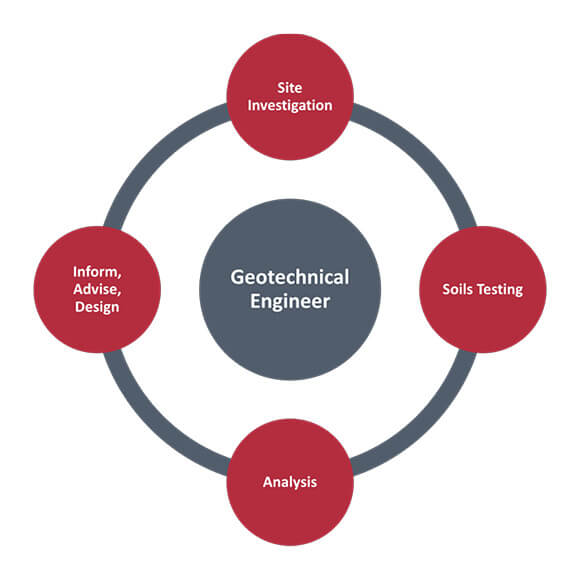Not known Facts About Geotheta
Wiki Article
More About Geotheta
Table of ContentsThe smart Trick of Geotheta That Nobody is Talking AboutThe smart Trick of Geotheta That Nobody is DiscussingThe Only Guide for GeothetaFascination About GeothetaExcitement About Geotheta

They conduct site examinations, accumulate examples, execute laboratory examinations, and analyze information to assess the suitability of the ground for construction jobs - Tailings Engineer. Based on their searchings for, geotechnical engineers provide recommendations for foundation layout, incline stability, preserving structures, and reduction of geotechnical hazards. They collaborate with various other professionals, such as engineers, architectural engineers, and construction teams, to ensure that geotechnical considerations are incorporated into the overall job layout and execution
By evaluating the habits and residential or commercial properties of dirt and rock, they can recognize prospective geotechnical dangers such as landslides, dirt settlement, or incline instability. Their experience helps avoid failings or crashes that can threaten lives and residential or commercial property. Here are some thorough duties and duties of a geotechnical designer: Site Examination: Geotechnical designers conduct site examinations to collect data on subsurface problems.
They analyze the information to comprehend the properties and habits of the dirt and rock, including their stamina, permeability, compaction attributes, and groundwater problems. Geotechnical Analysis and Layout: Geotechnical engineers examine the information accumulated throughout site examinations to evaluate the stability and suitability of the website for building jobs. They do geotechnical computations and modeling to assess factors such as birthing capability, negotiation, slope security, side earth stress, and groundwater circulation.
Some Ideas on Geotheta You Should Know
Foundation Style: Geotechnical engineers play an important role in creating structures that can securely support the desired structure. They evaluate the dirt conditions and tons needs to identify the suitable structure kind, such as superficial structures (e.g., grounds), deep foundations (e.g (https://issuu.com/geotheta)., piles), or specialized strategies like dirt improvement. They consider aspects such as negotiation limitations, bearing ability, and soil-structure interaction to establish optimal foundation designsThey examine building plans, display site tasks, and carry out area evaluations to verify that the layout suggestions are followed. If unexpected geotechnical concerns develop, they evaluate the scenario and offer recommendations for remediation or modifications to the design. Risk Analysis and Mitigation: Geotechnical designers evaluate geotechnical threats and threats connected with the task site, such as landslides, liquefaction, or soil disintegration.

Partnership and Interaction: Geotechnical engineers work carefully with various other experts associated with a task, such as engineers, structural designers, and construction groups. Effective interaction and cooperation are vital to integrate geotechnical considerations right into the overall task design and building and construction process. Geotechnical engineers give technical competence, solution queries, and guarantee that geotechnical needs are met.
See This Report about Geotheta
Right here are some types of geotechnical engineers: Foundation Engineer: Foundation engineers focus on creating and examining structures for frameworks. They assess the dirt conditions, load demands, and site characteristics to figure out one of the most appropriate foundation type and layout, such as superficial structures, deep structures, or specialized strategies like pile foundations.They evaluate the factors influencing incline security, such as dirt residential properties, groundwater problems, and incline geometry, and establish techniques to avoid slope failures and minimize risks. Quake Designer: Quake engineers focus on evaluating and making structures to withstand seismic forces. They assess the seismic danger of a website, examine dirt liquefaction capacity, and develop seismic style criteria to make certain the security and durability of structures throughout quakes.
They execute field screening, gather samples, and analyze the collected data to identify the dirt buildings, geologic developments, and groundwater problems at a website. Geotechnical Instrumentation Engineer: Geotechnical instrumentation engineers concentrate on monitoring and gauging the habits of soil, rock, and frameworks. They install and keep instrumentation systems that keep track of variables such as soil negotiation, groundwater degrees, slope movements, and architectural displacements to examine performance and give very early cautions of possible issues.
The Main Principles Of Geotheta
They perform tests such as triaxial tests, loan consolidation tests, straight shear tests, and permeability examinations to collect information for geotechnical analysis and design. Geosynthetics Designer: Geosynthetics engineers concentrate on the style and application of geosynthetic products, such as geotextiles, geogrids, and geomembranes. They make use of these materials to enhance dirt security, reinforce slopes, supply water drainage services, and control erosion.They have a tendency to be investigative individuals, which indicates they're intellectual, reflective, and inquisitive. They are curious, systematic, sensible, analytical, and rational. Some of them are additionally social, suggesting they're kind, generous, cooperative, client, caring, valuable, empathetic, tactful, and pleasant - Geotechnical Engineers.
In the workplace environment, geotechnical designers make use of specialized software tools to carry out computations, produce layouts, and analyze data. They prepare records, testimonial project specifications, communicate with clients and staff member, and coordinate project activities. The office setting offers a helpful atmosphere for research study, analysis, and cooperation with other experts associated with the project.
The Best Guide To Geotheta
They regularly check out project websites to conduct website investigations, assess geotechnical problems, and collect data for analysis. These visits involve taking a trip to various areas, occasionally in remote or difficult surfaces. Geotechnical engineers might perform soil sampling, conduct tests, and screen building tasks to guarantee that the geotechnical elements of the project are being carried out appropriately.Geotechnical designers likewise have a peek here function in specialized geotechnical research laboratories. Geotechnical research laboratory engineers work extensively in these environments, handling screening tools, running tools, and taping information.
Report this wiki page